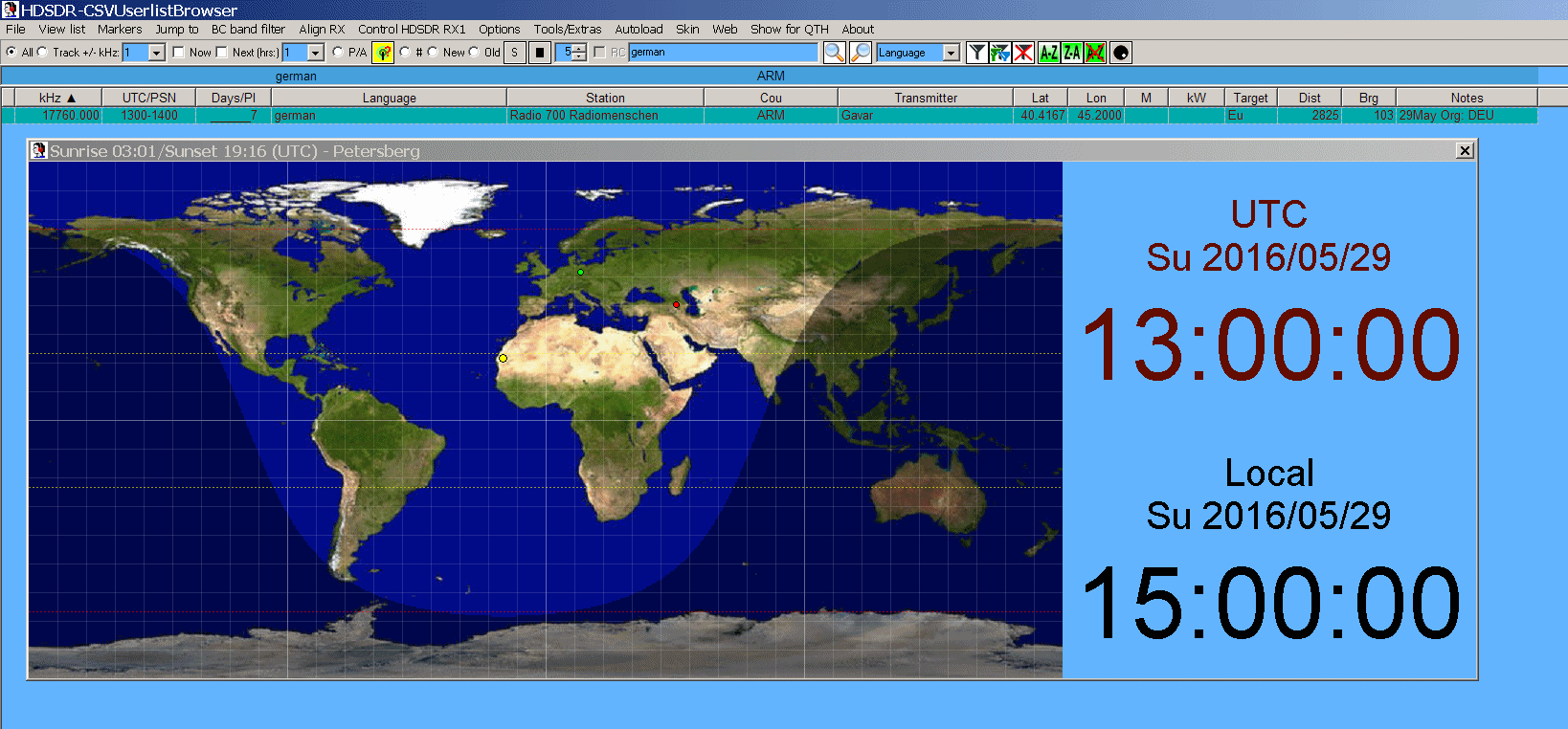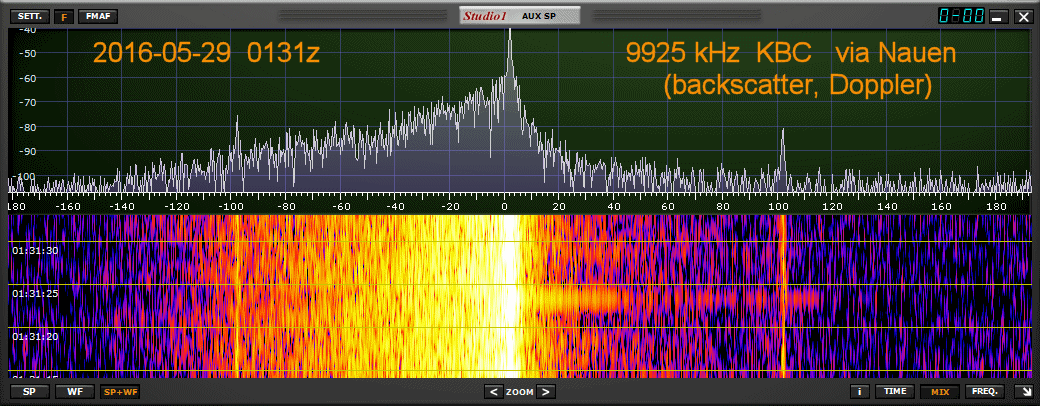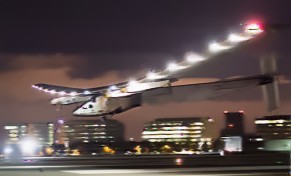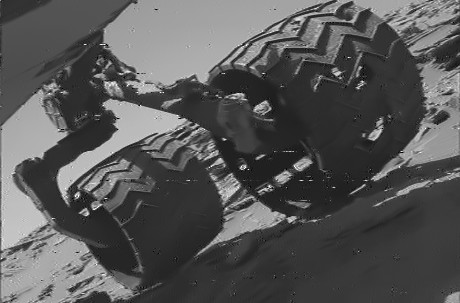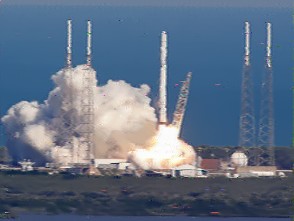██████╗ ██╗ ██████╗ ██╗ ██████╗ ██╗ ██╗
██╔══██╗██║██╔════╝ ██║ ██╔══██╗╚██╗██╔╝
██║ ██║██║██║ ███╗██║ ██║ ██║ ╚███╔╝
██║ ██║██║██║ ██║██║ ██║ ██║ ██╔██╗
██████╔╝██║╚██████╔╝██║ ██████╔╝██╔╝ ██╗
╚═════╝ ╚═╝ ╚═════╝ ╚═╝ ╚═════╝ ╚═╝ ╚═╝
6070 kHz AM [complementary data]
[2016-05-27/1830-1900z] QTH: D-01796 Pirna (Frank Kreuzinger)
[2016-05-28/1830-1900z] QTH: D-06193 Petersberg (Roger Thauer)
OLIVIA 16-500 @ 1500 Hz
(20 WPM, 500 Hz BW, 16-FSK) S/N -13dB!
MFSK-32 @ 2200 Hz
(120 WPM, 630 Hz BW, 16-FSK)
RSID: <<2016-05-28T18:30Z
OL 16-500 @ 17580000+1500>>
Hello and welcome to DigiDX 15. MFSK32 on 2200Hz.
Weekly schedule:
Sunday 2130 - 15770kHz via WRMI (Okeechobee,
FL, USA)
Sunday 2330 - 11580kHz via WRMI (Okeechobee, FL, USA)
Monday 2000 -
6070kHz via Channel 292 (Rohrbach Wall, DE)
Monday - Sunday 0530/1830 - 6070kHz via Channel 292 (Rohrbach Wall, DE)
Extra broadcasts will be listed on
http://www.digidx.uk
Latest Shortwave News:
Test broadcasts from ShortwaveService via Armenia
Updated RCI schedule via ShortwaveService
Babcock MW Tests
Saudi Radio Somali Broadcasts
Test broadcasts from ShortwaveService via Armenia
German private shortwave broadcaster ShortwaveService who are most well
known for transmitting Radio 700 to Europe and now also relaying Radio
Canada International and SRF Switzerland are to carry out a test
broadcast via the Yerevan-Gavar transmitter in Armenia.
The first test will be from 1300-1400 UTC on 17760kHz and will be the
German DX programme “Radio – Menschen & Geschichten (People and
Stories).
Updated RCI schedule via ShortwaveService
Thanks to regular
listener Richard Langley has emailed to let me know
about an extra broadcast of Radio Canada International’s The Link
programme via ShortwaveService.
This is every Sunday at 1400 on 6005kHz. The French programme “Tam-Tam
Canada"
continues to be heard every Saturday at 1400 on 6005kHz.
Babcock MW Tests
As we await further news on the BBC’s planned Korean service, it seems
that a test by Babcock could be to establish whether a MW frequency will
also be suitable for broadcasting to North Korea.
The test broadcast from Mongolia is on 1431kHz from 25th - 29th May.
The tests are official aimed at Southern China and the Korean Peninsula
which has led to the speculation they are for the BBC Korean Service.
DigiDX will bring updates on the commencement of the Korean service and
any further testing in future episodes.
Saudi Radio Somali Broadcasts
Saudi Radio has joined many other broadcasters in starting shortwave
transmissions in Somali targeted at East Africa.
The broadcasts can be heard on 13720kHz between 0700-0900.
Upcoming relays and special broadcasts:
Alaska based SWL Paul Walker has another shortwave broadcast next week:
WINB 9265khz Saturday June 4th 0230UTC to 0430UTC WRMI 7570 Saturday
June 4th 0400 to 0600UTC
SDRPlay vs RTL-SDR by Akos Czermann can be found in the MFSK32 and at
http://rtlsdr4everyone.blogspot.co.uk
Thank you for listening, please send reports to reports@digidx.uk.
This is DigiDX Signing off.....
Hello and welcome to DigiDX 15, a weekly review of the latest shortwave
and DX news broadcast mainly in MFSK32 mode. This broadcast includes
shortwave news, a comparison of the SDR Play RSP against the RTL SDR by
Akos Czermann, listeners letters and an over-the-air QSL card.
While this broadcast on 2200hz, a shorter version of the text from
today’s programme is also broadcast in Olivia 16-500 mode on 1500Hz.
To decode both streams either record the programme and decode twice or
open two instances of your decode software and centre one on 2200Hz
MFSK32 and one on 1500Hz Olivia 16-500.
DigiDX weekly schedule:
Sunday 2130 - 15770kHz via WRMI (Okeechobee, FL, USA)
Sunday 2330 - 11580kHz via WRMI (Okeechobee, FL, USA)
Monday 2000 - 6070kHz via Channel 292 (Rohrbach Wall, DE)
Thanks to Channel 292 we also have extra repeats of DigiDX every day on
6070kHz at 0530 and 1830UTC. This is to test against interference from
Vatican Radio. Thanks for DigiDX for broadcasting DigiDX on this extra
schedule, to buy shortwave time from Channel 292 at very reasonable
prices go to http://www.channel292.de.
Any other extra broadcasts will be listed on http://www.digidx.uk
Updated RCI schedule
via ShortwaveService
Babcock MW Tests
Saudi Radio Somali Broadcasts
If you enjoy DigiDX and find the service useful please consider donating
via Paypal to reports@digidx.uk
or via our Patreon page. Any money
donated will go towards paying for airtime to keep DigiDX on the air to
Europe and North America.
Every donation will help no matter how little
-
https://www.patreon.com/digidx
/ reports@digidx.uk
Thanks very much to listeners Fred Albertson, Mike Stapp, Mark
Braunstein and Richard Langley for contributing to the Patreon campaign.
Latest Shortwave News:
Test broadcasts from ShortwaveService via Armenia
Test broadcasts from ShortwaveService via Armenia
German private shortwave broadcaster ShortwaveService who are most well
known for transmitting Radio 700 to Europe and now also relaying Radio
Canada International and SRF Switzerland are to carry out a test
broadcast via the Yerevan-Gavar transmitter in Armenia.
The first test will be from 1300-1400 UTC on 17760kHz and will be the
German DX programme “Radio – Menschen & Geschichten (People and
Stories). The live version of the same programme will also be on 6045kHz
via Nauan at 0800UTC.
Other customers of the Yerevan-Gavar transmitter include the BBC and TWR
India.
Updated RCI schedule via ShortwaveService
Thanks to regular listener Richard Langley has emailed to let me know
about an extra broadcast
of Radio Canada International’s The Link
programme via ShortwaveService. Broadcasts started on the 1st of April
on Saturdays at 1400 on 7310kHz but an additional broadcast was added
from the 1st of May.
This is every Sunday also at 1400 but on one of ShortwaveService’s
other frequencies - 6005kHz. The French programme “Tam-Tam Canada"
continues to be heard every Saturday at 1400 on 6005kHz.
Richard has submitted a recording of the first Sunday broadcast of the
The Link to the excellent Shortwave Archive site. Listen to it here -
http://goo.gl/SfSLxb
Babcock MW Tests
As we await further news on the BBC’s planned Korean service, it seems
that a test by Babcock could be to establish whether a MW frequency will
also be suitable for broadcasting to North Korea.
Babcock who now own the transmitter sites around the world formerly
owned by the BBC before privatisation have scheduled a test broadcast
from Mongolia via 1431kHz from 25th - 29th May. The test has been heard
transmitting tones and an announcement from remote SDRs in Hong Kong and
South Korea at times between 1300 - 1900.
The tests are official aimed at Southern China and the Korean Peninsula
which has led to the speculation they are for the BBC Korean Service.
DigiDX will bring updates on the commencement of the Korean service and
any further testing in future episodes.
Saudi Radio Somali Broadcasts
Saudi Radio has joined many other broadcasters in starting shortwave
transmissions in Somali targeted at East Africa.
The broadcasts can be heard on 13720kHz between 0700-0900. Other
international broadcasters with Somali transmissions include Radio
Vatican, BBC, VOA ,
Radio Cairo and IBRA Radio.
Upcoming relays and special broadcasts:
Alaska based SWL Paul Walker has another shortwave broadcast next week
with the latest episode of his Classics Experience. Also featured on
this two hour broadcast is some MFSK32 text (in the 2nd half hour of the
broadcast) and an image (in the final half hour).
Paul says the broadcast will be rock and roll music with some country
classics and will have the following schedule:
WINB 9265khz Saturday June 4th 0230UTC to 0430UTC WRMI 7570 Saturday
June 4th 0400 to 0600UTC
Reception reports are only accepted by regular postal mail and $2 is
appreciated to cover the costs of the QSL cards and return postage:
Paul B. Walker, Jr. PO m353 Galena, Alaska 99741 USA
VOA Radiogram will be on air this weekend on the following frequencies,
for more information on the modes to be used visit
http://voaradiogram.net/
Sat 0930-1000 5745 kHz
Sat 1600-1630 17580 kHz
Sun 0230-0300 5745 kHz
Sun 1930-2000 15670 kHz
All broadcasts are from Greenville, NC.
SDRPlay vs RTL-SDR by Akos Czermann from
http://rtlsdr4everyone.blogspot.co.uk
The SDRPlay RSP is a software defined radio receiver, covering
frequencies between 100 kHz and 2GHz.
Available directly from the manufacturer (link) or from Ham Radio Outlet
in the USA (link), or any of the worldwide distributors (link).
Disclaimer: Most of the equipment in this post was received from
manufacturers as free loan or review samples. This has zero influence on
what I write, but you need to know. Also, SDRPlay checked the
preliminary version for factual errors, their comments are included at
my discretion. (After sending this over there were none). I wanted to
see if the SDRPlay is really that much better, and whether it's worth
upgrading from an RTL-SDR based setup.
Beginner note: if words, terminology or concepts sound strange, please
use google, or buy my book for 5 dollars written for people like you. It
is available on Amazon (link), or by clicking on the blue image on the
left. Thank you.
It's an unfair comparison
SDRPlay or RSP, used interchangeably, main features versus RTL-SDR
dongles: - 12-bit Analog-to-Digital conversion, (vs 8-bit),
theoretically a higher ADC value is better, - built-in preamplifier for
VHF and up (vs external LNA4ALL (link), - built-in Upconverter (vs
external upconverter like Ham-It-Up v1.3 (link), - built-in Filters (vs
external solutions), - up to 8 MHz bandwidth (vs 2.4 - 2.8 MHz for
RTL-SDR dongles), - "All-in-one" package (vs adapters and pigtails). -
no TCXO (vs TCXO with $20 dongles)
Costs
The USA is the most developed nation in the world with the highest
per-capita GDP, yet 14.8 % of the population lives below the poverty
line: over 45 million people get by on less than $500 a week. This is
not a comment on fiscal policy, these are facts; especially in light of
statements praising the SDRPlay as being "cheap". The RSP is priced at
$149 plus shipping in the USA, but costs significantly more elsewhere:
for example, it 's close to ~$190 delivered to Ireland. Manufacturer
offers 6 month's warranty. RTL-SDR.com dongles officially come with 6
months, Nooelec gives you two years with the Plus series. However, I
seriously doubt any maker named above will hesitate the slightest to
replace a faulty unit after warranty expires. To get even close to the
RSP's claimed performance, we'll need to source components separately
for RTL-SDRs.
No-frills without preamp (~$66), covers the same frequency spectrum,
dongle plus upconverter and pigtails. Budget equivalent ($92): Noname
RTL-SDR dongle for $10 (R820T2, no TCXO), bare upconverter board for
$50, MCX-SMA and SMA-SMA pigtails ($6), LNA4ALL ($26). Five different
suppliers. Sensible equivalent ($107): upgrade dongle to TCXO (+$15),
either from rtl-sdr.com or Nooelec. Top-components equivalent ($135):
add a metal case to the upconverter (+$22), use better pigtails (+$6).
Questions for the reader
Ask yourself whether the answer is "Yes" to any, or all of the
following:
- Do you have ~ 150-200 dollars for an SDR receiver? - Would 8 a larger
visible frequency span make your life / reception experience better? -
Do you have a fast enough computer for 8 MHz span? - Do you enjoy
chasing really weak signals? This ties to the next question: - Do you
possess the antenna systems, knowledge and time to get the best out an
RSP?
In the box and first impressions Signed-for DHL shipping, UK to Ireland
took two days. I love no waiting. Small black box in see-thru plastic,
looks and feels like a Christmas bauble box. The receiver itself fits
into the palm of my hand, not that I would want it to: plastic quality
and tactile feel is terrible, midway between a toilet brush and
disposable cutlery. In comparison, a Nooelec metal case is reassuringly
solid, and rtl-sdr.com's dongle is so smooth with its rounded edges and
satin finish that it's good just to pick it up. And no power/data USB-B
cable. The target market will, obviously, possess a suitable cable, but
at the end of the day, for $150 you get a paperweight, as the device is
not usable out of the box. No antennas nor cables whatsoever, not even a
small telescopic. Come on. Summary: "no supplied cable" is one of my pet
hates, but for $150 this cannot be ignored. The feel of the actual unit
is so awful I didn't want to touch it, and that resilience hasn't
changed. A metal case should be compulsory at this price point, or at
least the option to order a complete package with a large telescopic on
a magnetic mount and power/data cable with chunky ferrites on both ends.
Secondary opinion: a woman's perspective
The suffering subject is my mother this time. "I love the rounded edges,
the plastic feels smooth and inviting. Only two holes, probably I can
put this together. This would look good on an executive desk, the logo
with the lightning is well made. Handing her a metal cased upconverter
and Nooelec dongle, connected with a pigtail: "Why all the wires? I
don't like the metal case, what would happen if I accidentally knock it
off from the table? It could damage the tiles, with the plastic at least
the case would break. I tell her the SDRPlay costs more than double and
offers much more for the price: "I'd save up and get the little black
box, everything in one box. No cables."
Conclusion: Mothers are always right.
Support
Big brownie points for official support, easy to navigate website with
links to required configuration files, along with helpful guides for
software setup - all front-end software worked seamlessly following
manufacturer instructions. Facebook group available, closed but I got
approved in a few minutes, active members, questions get answered. I'd
recommend the RSP purely on support alone, even if you have no clue what
to do, or wonder how to set up HDSDR for shortwave. The possibility of
asking someone for help cannot be underestimated.
Hardware
If your computer run3RTL-SDR dongles, it will run the SDRPlay. Sample
size (how much frequency is visible) determines computer requirements,
to get the highest span a very powerful processor (read: $$$) will be
required. Intermediate laptop: On an Intel Core i3-2330 M @ 2.2 GHz, 8GB
RAM and SSD hard drive, RTL dongle at 2 MHz sample rate had 35-40 % CPU
load. SDRPlay at 5MHz sample rate, processor stayed around 20-25 %
utilization figure. A laptop like this costs from 300 dollars and up.
Normal Laptop: On an Intel Core 2 Duo @ 2.0 GHz, 4GB RAM, with the
SDRPlay only 2MHz sample rate could be relected without audio
stuttering. A laptop like this costs from 200 dollars and up.
No driver, no port hassle
Once the initial driver installation completed, the SDRPlay can be used
with any USB port, and usable as a TV tuner without driver
reinstallation. In comparison, the same USB port must be used with
dongles and TV tuner use requires a different driver. If you ever tried
to restore a wireless keyboard driver in Device Manager, because you
mistakenly overwritten the driver with Zadig, you'll appreciate this.
Plus no bother with external USB hubs: see a free USB port and you're
good.
Testing setup and methodology Testing took a month: in four cities,
various urban / suburban RFI environments, and down the country at
several locations . No fancy pancy noise reduction measures. USB
extension lead used with bias-T enabled rtl-sdr.com dongles and Nooelec
dongles in a metal case, plus LNA4ALL and LNA4HF from Adam. VHF:
Commercial discone, antenna splitter, identical coax lengths with
Nooelec pigtails (which are abused for a long time without any sign of
wear, good stuff). Standard supplied RTL-SDR collapsibles on magnetic
mounts were also used. HF: multi-stranded copper wire, 1.5 mm diameter.
Various antenna lengths, with and without Balun One Nine and homemade
9:1 UnUn. Methodology: I'm new to SDRPlay and its myriad levels of gain
settings, but tend to think I know RTL dongles a little bit.
Consequently, I tuned to a signal with an RTL dongle, tried to get the
best reception with either SDR# / HDSDR / SDR Console, then attempted to
get same or better performance with SDRPlay in the same software. When
I've seen a juicy weak signal with the SDRPlay, I tried to get it with
the applicable dongle configuration.
Attitude
I'm grossly uninterested in technical specifications, couldn't care less
for published or claimed figures, or in the 8-bit vs 12 bit debate; I
live in the real world, not in a lab. To start an analogy, I've driven a
small roadster (Mazda MX-5) and had much more fun than in a car with
twice the power (Subaru Impreza). Was the Mazda a better car? Yes, for
me. Did Subaru won numerous rally championships? Sure. Everything
depends on personal circumsances and what you enjoy. Furthermore, I
don't wish to build a statue to either the SDRPlay or RTL dongles. The
purpose here is to provide insight, as I'm lucky enough to receive gear
from good manufacturers and have the time to test them. I simply sit
down and enjoy listening to radio, like I do for the past 25+ years.
Please feel free to make an informed decision, it's your money after
all.
Software front-end choices
Runs best on software you might not have heard about, namely HDSDR and
SDR Console - manufacturer offers free, and excellent Getting Started
guides on both. SDR Console looks 21st century, v 2.3 used for testing,
v3 looks nice but freezes and crashes too often. Natively supports the
RSP and works with RTL dongles too. HDSDR looks archaic and control
buttons are small, but works wonderfully, uses the least amount of
resources. SDRSharp is supported and works, but often froze after an
extended session; it's still the easiest to use, but as its developers
are tied to the direct competitor AirSpy, it's not the best choice.
Part 2 including information on performance, comparisons to other SDRs
and conclusions will be in the next episode of DigiDX.
Thank you for all the reception reports sent to reports@digidx.uk. We
have had a few extra broadcasts this week as mentioned earlier by
Channel 292 on 6070 and also on Saturday and Sunday by Dutch pirate the
Shortwave Python on 6325kHz in AM mode and 6255 in USB mode. Please
check out website www.digidx.uk
and Facebook page
https://www.facebook.com/digidx/
for news of extra broadcasts.
The main test in last week's broadcast was the Olivia 16-500 mode
broadcast on 2200Hz. Where reception was marginal this did show a better
decode than MFSK32 on 1500Hz but it really came into its own in a
special broadcast on Saturday at 1830UTC on 6070 at the same time and
frequency as a strong Vatican radio broadcast.
For example LA7UM Finn in Norway writes “Impression is that Olivia
16-500 did a good job through that strong "jamming". It seems being THE
robust broadcast mode with some speed” and Frank Kreuzinger in Germany
says “Olivia 16-500 on 2200 Hz I decoded a few minutes ago with good
result, not without failures but very much better than MFSK-32 while
Vatican Radios modulation.!! ...unbelievaible!”
Andreja Kostić in Kiel, Germany started decoding the MFSK32 without
issues until the Vatican broadcast started at 1840 when that mode
quickly deteriorated and he also heard some interference sounding like
an OTHR. However he writes “On the other hand, I must say that the
Olivia came through very nicely! There were only a few missed letters
and the only big issue came up during the interference I mentioned in
the previous paragraph”
Please let us know by email if anyone else has suffered any interference
from this possible OTHR.
Finally Willy Anderson in Denmark wrote to say “MFSK32 is OK until
1840utc when Vatican came on then very poor. OLIVIA very good of
decoding of the text better than 95%.I am
suprised when looking at the
WF that it is possible to decode”.
As mentioned there will be extra broadcasts again to test against
Vatican interference on 6070 this week, this will be in Olivia 16-500 on
1500Hz and MFSK32 on 2200Hz.
Now follows this weeks E-QSL card, sent as an MFSK32 image.
Sending Pic:432x260;
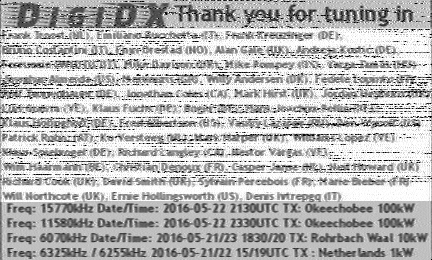 [Frank K./Pirna]
[Frank K./Pirna]
Thank you for listening, please send reports, comments and shortwave related
news or articles to reports@digidx.uk.
This is DigiDX Signing off.....
